Detailed Corporate and Financial Accounting Report: JKY Ltd & FAB Ltd
VerifiedAdded on 2020/10/22
|11
|3002
|326
Report
AI Summary
This report offers a detailed analysis of corporate and financial accounting, focusing on the scenario of JKY Ltd's potential acquisition of FAB Ltd. It begins with an executive summary and introduction, defining corporate and financial accounting and highlighting their importance. The main body of the report is divided into three parts. Part A explores legislative requirements in company formation and the methods of acquiring a business, including purchase and equity methods, along with the consolidation and equity accounting techniques. Part B delves into intra-group transactions, outlining issues that arise and the principles to manage them, referencing AASB standards. Finally, Part C examines non-controlling interest (NCI), its impact on financial statements, and various issues that arise during the consolidation process, such as scaling multiple systems, currency issues, setting interrelating transactions, and understanding consolidation. The report concludes by summarizing the key findings and implications of the analysis, providing a comprehensive overview of the financial and accounting considerations involved in corporate acquisitions and consolidations.

CORPORATE AND
FINANCIAL
ACCOUNTING
FINANCIAL
ACCOUNTING
Paraphrase This Document
Need a fresh take? Get an instant paraphrase of this document with our AI Paraphraser
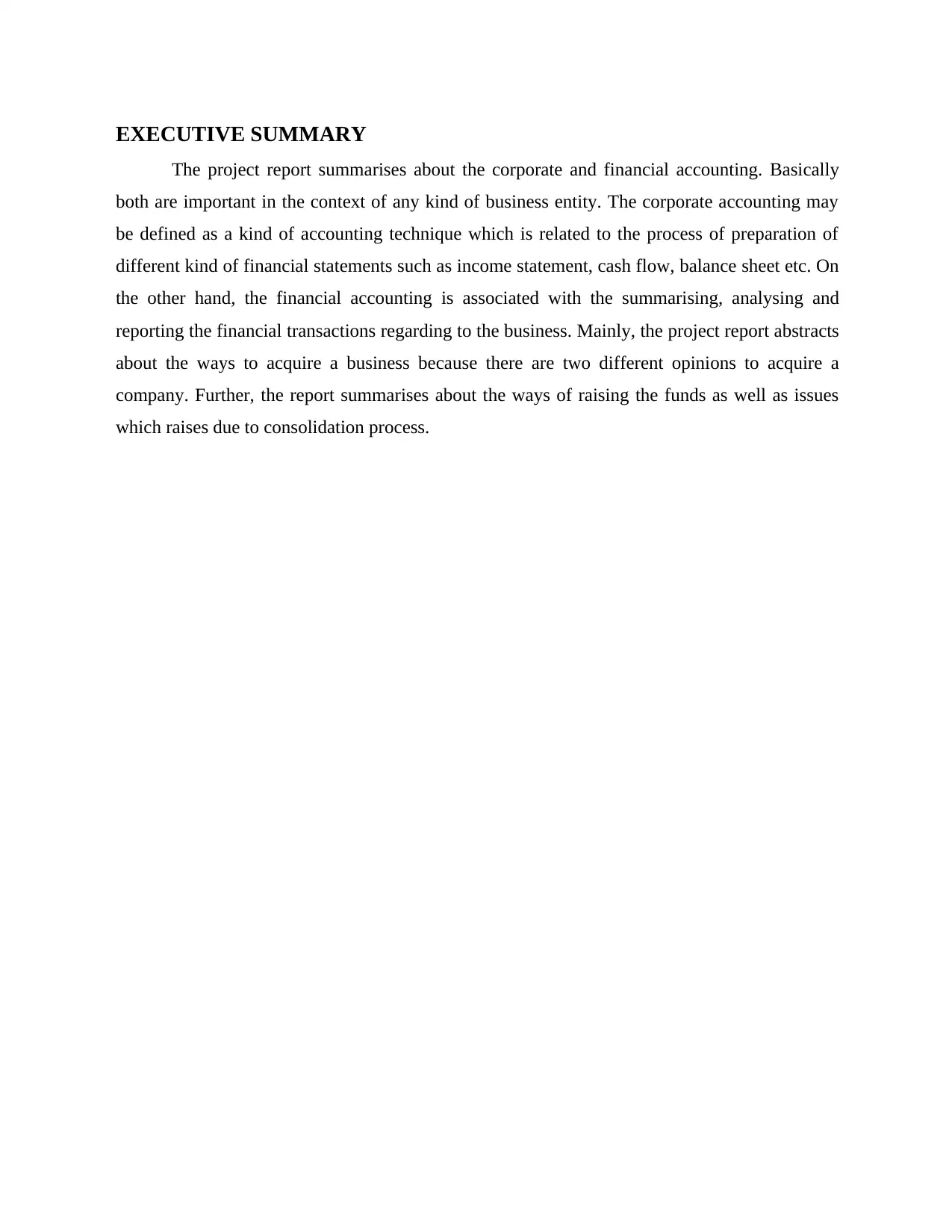
EXECUTIVE SUMMARY
The project report summarises about the corporate and financial accounting. Basically
both are important in the context of any kind of business entity. The corporate accounting may
be defined as a kind of accounting technique which is related to the process of preparation of
different kind of financial statements such as income statement, cash flow, balance sheet etc. On
the other hand, the financial accounting is associated with the summarising, analysing and
reporting the financial transactions regarding to the business. Mainly, the project report abstracts
about the ways to acquire a business because there are two different opinions to acquire a
company. Further, the report summarises about the ways of raising the funds as well as issues
which raises due to consolidation process.
The project report summarises about the corporate and financial accounting. Basically
both are important in the context of any kind of business entity. The corporate accounting may
be defined as a kind of accounting technique which is related to the process of preparation of
different kind of financial statements such as income statement, cash flow, balance sheet etc. On
the other hand, the financial accounting is associated with the summarising, analysing and
reporting the financial transactions regarding to the business. Mainly, the project report abstracts
about the ways to acquire a business because there are two different opinions to acquire a
company. Further, the report summarises about the ways of raising the funds as well as issues
which raises due to consolidation process.
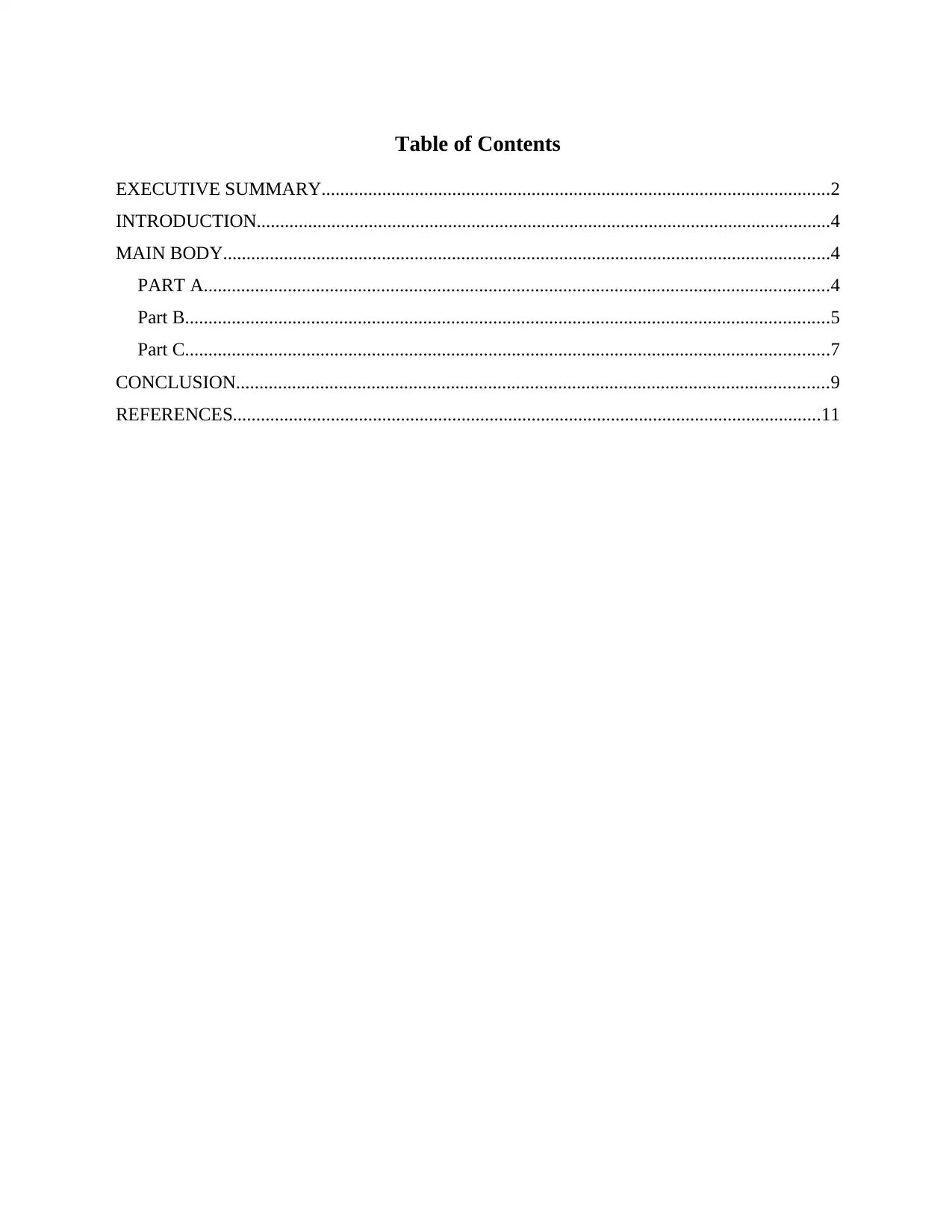
Table of Contents
EXECUTIVE SUMMARY.............................................................................................................2
INTRODUCTION...........................................................................................................................4
MAIN BODY..................................................................................................................................4
PART A......................................................................................................................................4
Part B..........................................................................................................................................5
Part C..........................................................................................................................................7
CONCLUSION...............................................................................................................................9
REFERENCES..............................................................................................................................11
EXECUTIVE SUMMARY.............................................................................................................2
INTRODUCTION...........................................................................................................................4
MAIN BODY..................................................................................................................................4
PART A......................................................................................................................................4
Part B..........................................................................................................................................5
Part C..........................................................................................................................................7
CONCLUSION...............................................................................................................................9
REFERENCES..............................................................................................................................11
⊘ This is a preview!⊘
Do you want full access?
Subscribe today to unlock all pages.

Trusted by 1+ million students worldwide
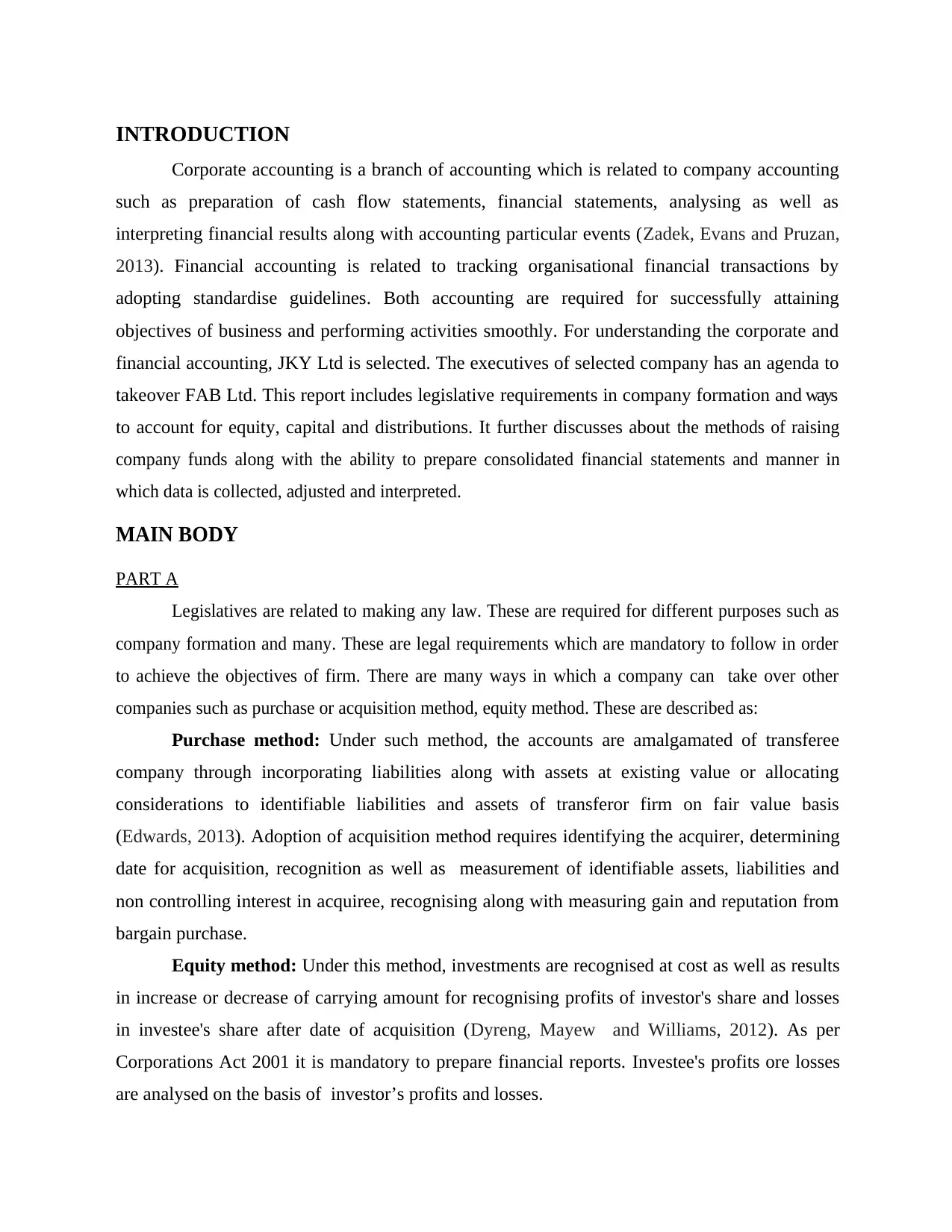
INTRODUCTION
Corporate accounting is a branch of accounting which is related to company accounting
such as preparation of cash flow statements, financial statements, analysing as well as
interpreting financial results along with accounting particular events (Zadek, Evans and Pruzan,
2013). Financial accounting is related to tracking organisational financial transactions by
adopting standardise guidelines. Both accounting are required for successfully attaining
objectives of business and performing activities smoothly. For understanding the corporate and
financial accounting, JKY Ltd is selected. The executives of selected company has an agenda to
takeover FAB Ltd. This report includes legislative requirements in company formation and ways
to account for equity, capital and distributions. It further discusses about the methods of raising
company funds along with the ability to prepare consolidated financial statements and manner in
which data is collected, adjusted and interpreted.
MAIN BODY
PART A
Legislatives are related to making any law. These are required for different purposes such as
company formation and many. These are legal requirements which are mandatory to follow in order
to achieve the objectives of firm. There are many ways in which a company can take over other
companies such as purchase or acquisition method, equity method. These are described as:
Purchase method: Under such method, the accounts are amalgamated of transferee
company through incorporating liabilities along with assets at existing value or allocating
considerations to identifiable liabilities and assets of transferor firm on fair value basis
(Edwards, 2013). Adoption of acquisition method requires identifying the acquirer, determining
date for acquisition, recognition as well as measurement of identifiable assets, liabilities and
non controlling interest in acquiree, recognising along with measuring gain and reputation from
bargain purchase.
Equity method: Under this method, investments are recognised at cost as well as results
in increase or decrease of carrying amount for recognising profits of investor's share and losses
in investee's share after date of acquisition (Dyreng, Mayew and Williams, 2012). As per
Corporations Act 2001 it is mandatory to prepare financial reports. Investee's profits ore losses
are analysed on the basis of investor’s profits and losses.
Corporate accounting is a branch of accounting which is related to company accounting
such as preparation of cash flow statements, financial statements, analysing as well as
interpreting financial results along with accounting particular events (Zadek, Evans and Pruzan,
2013). Financial accounting is related to tracking organisational financial transactions by
adopting standardise guidelines. Both accounting are required for successfully attaining
objectives of business and performing activities smoothly. For understanding the corporate and
financial accounting, JKY Ltd is selected. The executives of selected company has an agenda to
takeover FAB Ltd. This report includes legislative requirements in company formation and ways
to account for equity, capital and distributions. It further discusses about the methods of raising
company funds along with the ability to prepare consolidated financial statements and manner in
which data is collected, adjusted and interpreted.
MAIN BODY
PART A
Legislatives are related to making any law. These are required for different purposes such as
company formation and many. These are legal requirements which are mandatory to follow in order
to achieve the objectives of firm. There are many ways in which a company can take over other
companies such as purchase or acquisition method, equity method. These are described as:
Purchase method: Under such method, the accounts are amalgamated of transferee
company through incorporating liabilities along with assets at existing value or allocating
considerations to identifiable liabilities and assets of transferor firm on fair value basis
(Edwards, 2013). Adoption of acquisition method requires identifying the acquirer, determining
date for acquisition, recognition as well as measurement of identifiable assets, liabilities and
non controlling interest in acquiree, recognising along with measuring gain and reputation from
bargain purchase.
Equity method: Under this method, investments are recognised at cost as well as results
in increase or decrease of carrying amount for recognising profits of investor's share and losses
in investee's share after date of acquisition (Dyreng, Mayew and Williams, 2012). As per
Corporations Act 2001 it is mandatory to prepare financial reports. Investee's profits ore losses
are analysed on the basis of investor’s profits and losses.
Paraphrase This Document
Need a fresh take? Get an instant paraphrase of this document with our AI Paraphraser
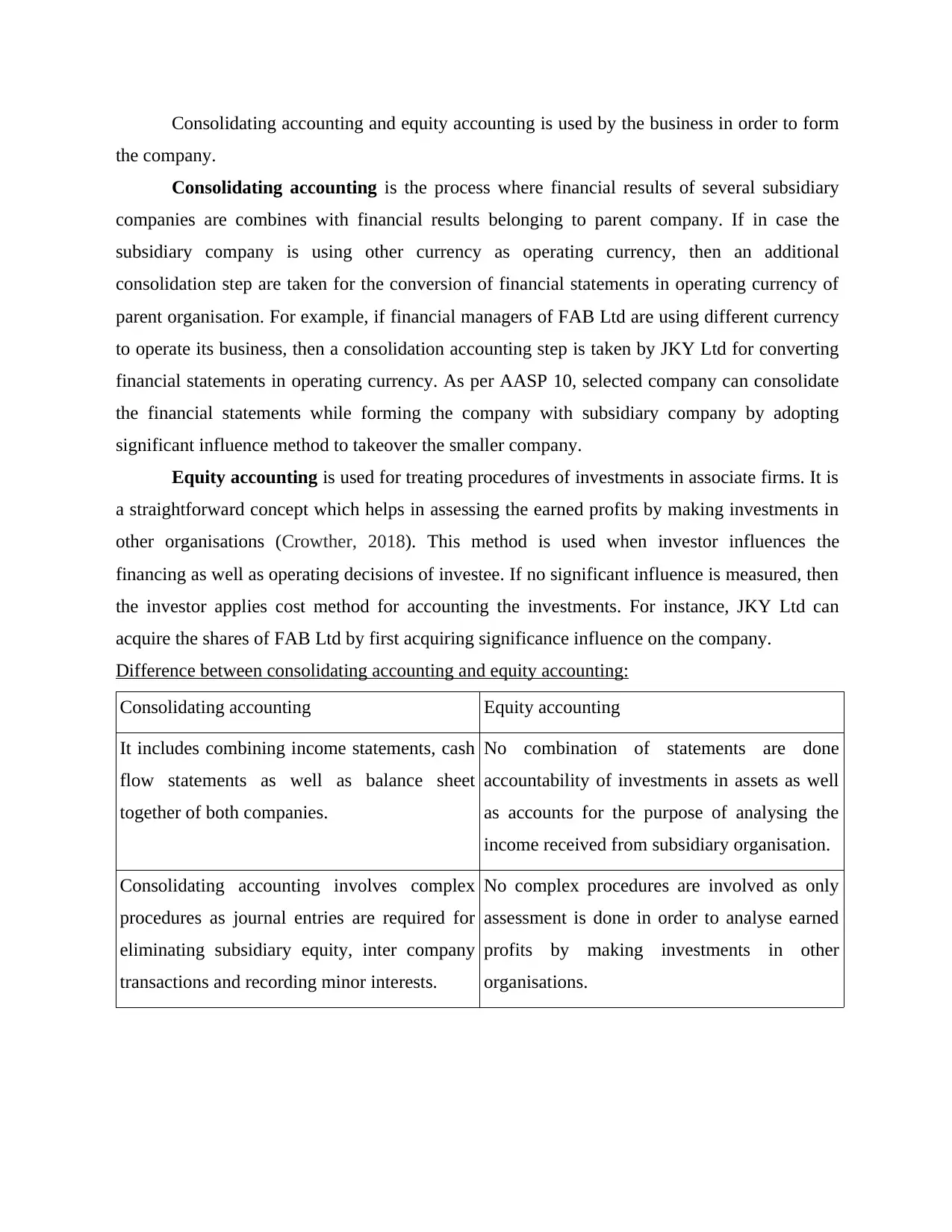
Consolidating accounting and equity accounting is used by the business in order to form
the company.
Consolidating accounting is the process where financial results of several subsidiary
companies are combines with financial results belonging to parent company. If in case the
subsidiary company is using other currency as operating currency, then an additional
consolidation step are taken for the conversion of financial statements in operating currency of
parent organisation. For example, if financial managers of FAB Ltd are using different currency
to operate its business, then a consolidation accounting step is taken by JKY Ltd for converting
financial statements in operating currency. As per AASP 10, selected company can consolidate
the financial statements while forming the company with subsidiary company by adopting
significant influence method to takeover the smaller company.
Equity accounting is used for treating procedures of investments in associate firms. It is
a straightforward concept which helps in assessing the earned profits by making investments in
other organisations (Crowther, 2018). This method is used when investor influences the
financing as well as operating decisions of investee. If no significant influence is measured, then
the investor applies cost method for accounting the investments. For instance, JKY Ltd can
acquire the shares of FAB Ltd by first acquiring significance influence on the company.
Difference between consolidating accounting and equity accounting:
Consolidating accounting Equity accounting
It includes combining income statements, cash
flow statements as well as balance sheet
together of both companies.
No combination of statements are done
accountability of investments in assets as well
as accounts for the purpose of analysing the
income received from subsidiary organisation.
Consolidating accounting involves complex
procedures as journal entries are required for
eliminating subsidiary equity, inter company
transactions and recording minor interests.
No complex procedures are involved as only
assessment is done in order to analyse earned
profits by making investments in other
organisations.
the company.
Consolidating accounting is the process where financial results of several subsidiary
companies are combines with financial results belonging to parent company. If in case the
subsidiary company is using other currency as operating currency, then an additional
consolidation step are taken for the conversion of financial statements in operating currency of
parent organisation. For example, if financial managers of FAB Ltd are using different currency
to operate its business, then a consolidation accounting step is taken by JKY Ltd for converting
financial statements in operating currency. As per AASP 10, selected company can consolidate
the financial statements while forming the company with subsidiary company by adopting
significant influence method to takeover the smaller company.
Equity accounting is used for treating procedures of investments in associate firms. It is
a straightforward concept which helps in assessing the earned profits by making investments in
other organisations (Crowther, 2018). This method is used when investor influences the
financing as well as operating decisions of investee. If no significant influence is measured, then
the investor applies cost method for accounting the investments. For instance, JKY Ltd can
acquire the shares of FAB Ltd by first acquiring significance influence on the company.
Difference between consolidating accounting and equity accounting:
Consolidating accounting Equity accounting
It includes combining income statements, cash
flow statements as well as balance sheet
together of both companies.
No combination of statements are done
accountability of investments in assets as well
as accounts for the purpose of analysing the
income received from subsidiary organisation.
Consolidating accounting involves complex
procedures as journal entries are required for
eliminating subsidiary equity, inter company
transactions and recording minor interests.
No complex procedures are involved as only
assessment is done in order to analyse earned
profits by making investments in other
organisations.
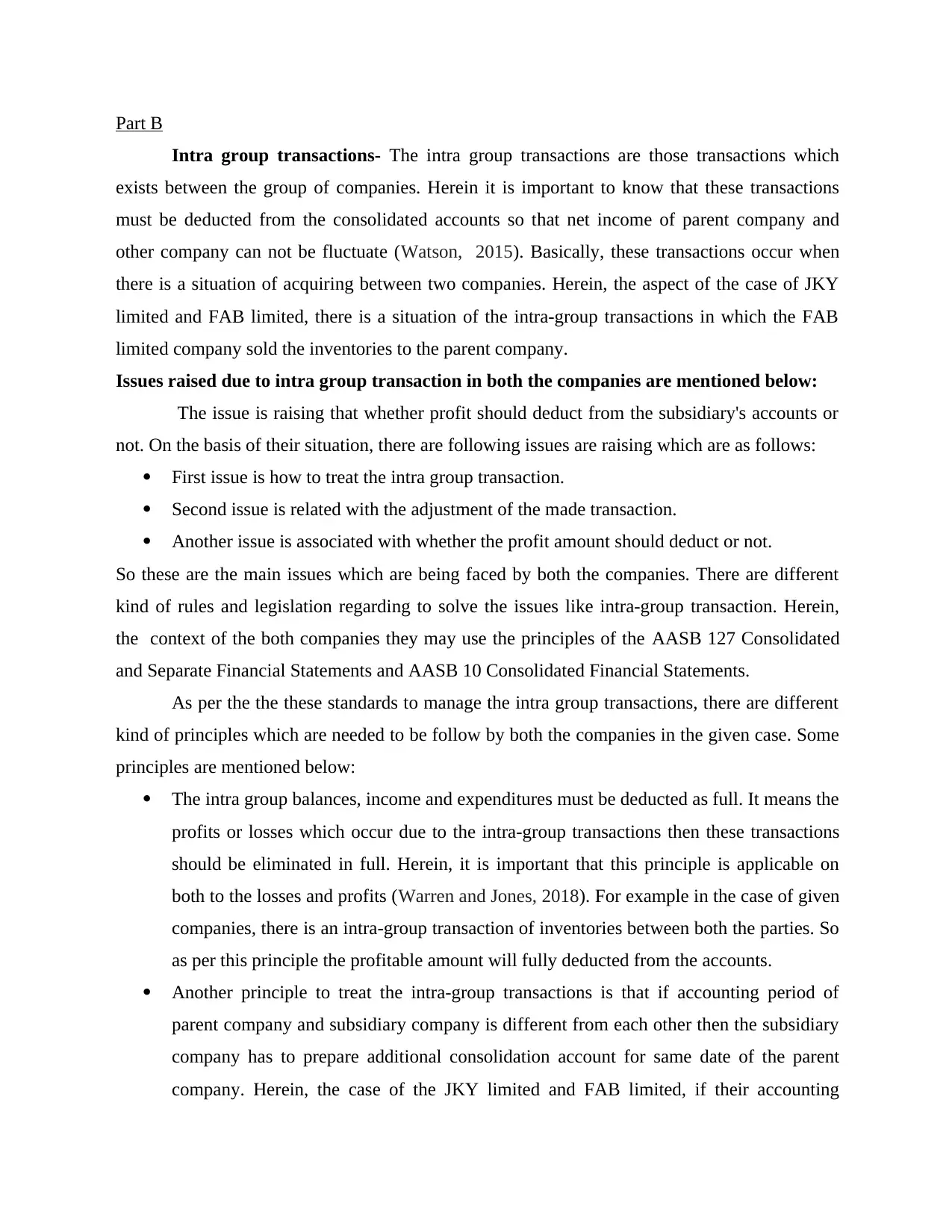
Part B
Intra group transactions- The intra group transactions are those transactions which
exists between the group of companies. Herein it is important to know that these transactions
must be deducted from the consolidated accounts so that net income of parent company and
other company can not be fluctuate (Watson, 2015). Basically, these transactions occur when
there is a situation of acquiring between two companies. Herein, the aspect of the case of JKY
limited and FAB limited, there is a situation of the intra-group transactions in which the FAB
limited company sold the inventories to the parent company.
Issues raised due to intra group transaction in both the companies are mentioned below:
The issue is raising that whether profit should deduct from the subsidiary's accounts or
not. On the basis of their situation, there are following issues are raising which are as follows:
First issue is how to treat the intra group transaction.
Second issue is related with the adjustment of the made transaction.
Another issue is associated with whether the profit amount should deduct or not.
So these are the main issues which are being faced by both the companies. There are different
kind of rules and legislation regarding to solve the issues like intra-group transaction. Herein,
the context of the both companies they may use the principles of the AASB 127 Consolidated
and Separate Financial Statements and AASB 10 Consolidated Financial Statements.
As per the the these standards to manage the intra group transactions, there are different
kind of principles which are needed to be follow by both the companies in the given case. Some
principles are mentioned below:
The intra group balances, income and expenditures must be deducted as full. It means the
profits or losses which occur due to the intra-group transactions then these transactions
should be eliminated in full. Herein, it is important that this principle is applicable on
both to the losses and profits (Warren and Jones, 2018). For example in the case of given
companies, there is an intra-group transaction of inventories between both the parties. So
as per this principle the profitable amount will fully deducted from the accounts.
Another principle to treat the intra-group transactions is that if accounting period of
parent company and subsidiary company is different from each other then the subsidiary
company has to prepare additional consolidation account for same date of the parent
company. Herein, the case of the JKY limited and FAB limited, if their accounting
Intra group transactions- The intra group transactions are those transactions which
exists between the group of companies. Herein it is important to know that these transactions
must be deducted from the consolidated accounts so that net income of parent company and
other company can not be fluctuate (Watson, 2015). Basically, these transactions occur when
there is a situation of acquiring between two companies. Herein, the aspect of the case of JKY
limited and FAB limited, there is a situation of the intra-group transactions in which the FAB
limited company sold the inventories to the parent company.
Issues raised due to intra group transaction in both the companies are mentioned below:
The issue is raising that whether profit should deduct from the subsidiary's accounts or
not. On the basis of their situation, there are following issues are raising which are as follows:
First issue is how to treat the intra group transaction.
Second issue is related with the adjustment of the made transaction.
Another issue is associated with whether the profit amount should deduct or not.
So these are the main issues which are being faced by both the companies. There are different
kind of rules and legislation regarding to solve the issues like intra-group transaction. Herein,
the context of the both companies they may use the principles of the AASB 127 Consolidated
and Separate Financial Statements and AASB 10 Consolidated Financial Statements.
As per the the these standards to manage the intra group transactions, there are different
kind of principles which are needed to be follow by both the companies in the given case. Some
principles are mentioned below:
The intra group balances, income and expenditures must be deducted as full. It means the
profits or losses which occur due to the intra-group transactions then these transactions
should be eliminated in full. Herein, it is important that this principle is applicable on
both to the losses and profits (Warren and Jones, 2018). For example in the case of given
companies, there is an intra-group transaction of inventories between both the parties. So
as per this principle the profitable amount will fully deducted from the accounts.
Another principle to treat the intra-group transactions is that if accounting period of
parent company and subsidiary company is different from each other then the subsidiary
company has to prepare additional consolidation account for same date of the parent
company. Herein, the case of the JKY limited and FAB limited, if their accounting
⊘ This is a preview!⊘
Do you want full access?
Subscribe today to unlock all pages.

Trusted by 1+ million students worldwide
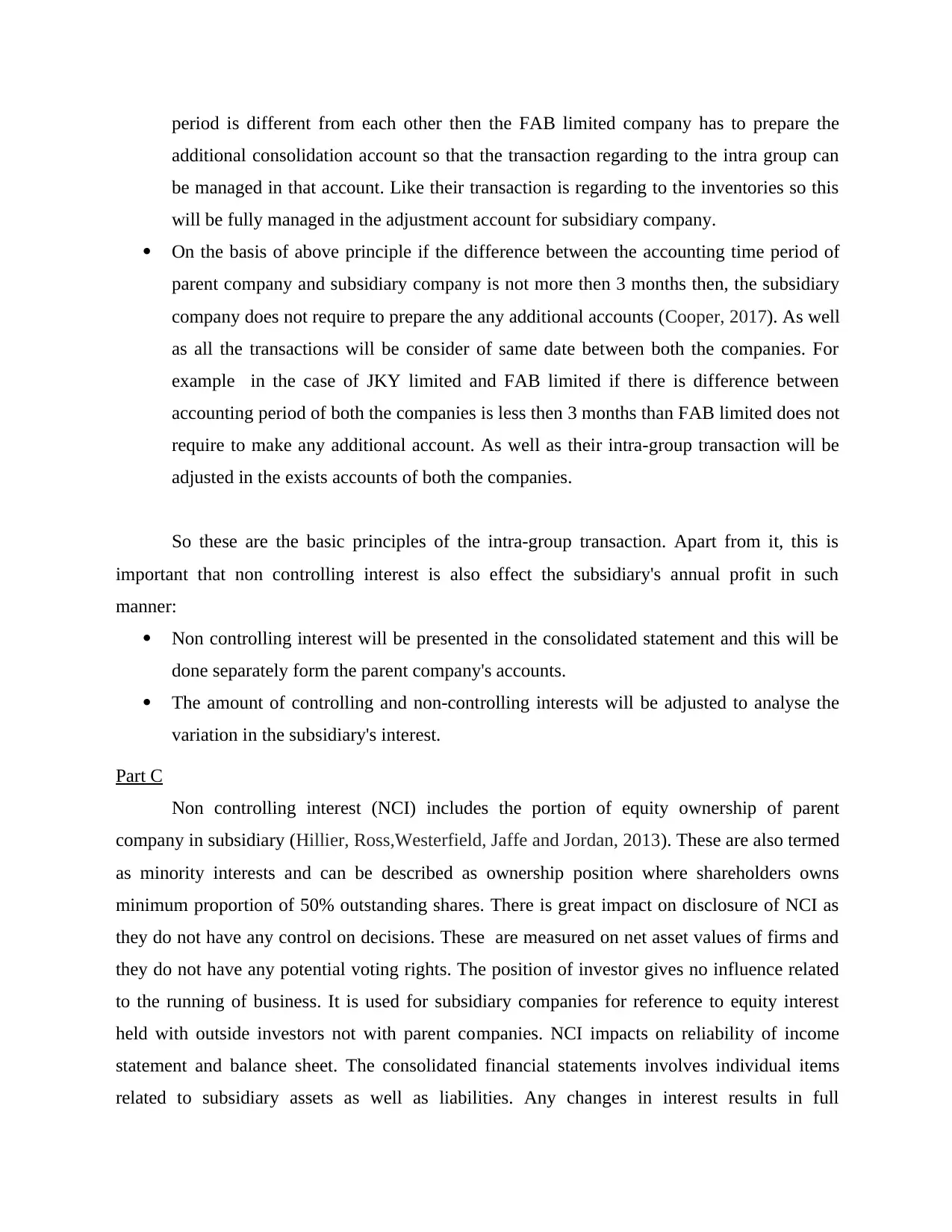
period is different from each other then the FAB limited company has to prepare the
additional consolidation account so that the transaction regarding to the intra group can
be managed in that account. Like their transaction is regarding to the inventories so this
will be fully managed in the adjustment account for subsidiary company.
On the basis of above principle if the difference between the accounting time period of
parent company and subsidiary company is not more then 3 months then, the subsidiary
company does not require to prepare the any additional accounts (Cooper, 2017). As well
as all the transactions will be consider of same date between both the companies. For
example in the case of JKY limited and FAB limited if there is difference between
accounting period of both the companies is less then 3 months than FAB limited does not
require to make any additional account. As well as their intra-group transaction will be
adjusted in the exists accounts of both the companies.
So these are the basic principles of the intra-group transaction. Apart from it, this is
important that non controlling interest is also effect the subsidiary's annual profit in such
manner:
Non controlling interest will be presented in the consolidated statement and this will be
done separately form the parent company's accounts.
The amount of controlling and non-controlling interests will be adjusted to analyse the
variation in the subsidiary's interest.
Part C
Non controlling interest (NCI) includes the portion of equity ownership of parent
company in subsidiary (Hillier, Ross,Westerfield, Jaffe and Jordan, 2013). These are also termed
as minority interests and can be described as ownership position where shareholders owns
minimum proportion of 50% outstanding shares. There is great impact on disclosure of NCI as
they do not have any control on decisions. These are measured on net asset values of firms and
they do not have any potential voting rights. The position of investor gives no influence related
to the running of business. It is used for subsidiary companies for reference to equity interest
held with outside investors not with parent companies. NCI impacts on reliability of income
statement and balance sheet. The consolidated financial statements involves individual items
related to subsidiary assets as well as liabilities. Any changes in interest results in full
additional consolidation account so that the transaction regarding to the intra group can
be managed in that account. Like their transaction is regarding to the inventories so this
will be fully managed in the adjustment account for subsidiary company.
On the basis of above principle if the difference between the accounting time period of
parent company and subsidiary company is not more then 3 months then, the subsidiary
company does not require to prepare the any additional accounts (Cooper, 2017). As well
as all the transactions will be consider of same date between both the companies. For
example in the case of JKY limited and FAB limited if there is difference between
accounting period of both the companies is less then 3 months than FAB limited does not
require to make any additional account. As well as their intra-group transaction will be
adjusted in the exists accounts of both the companies.
So these are the basic principles of the intra-group transaction. Apart from it, this is
important that non controlling interest is also effect the subsidiary's annual profit in such
manner:
Non controlling interest will be presented in the consolidated statement and this will be
done separately form the parent company's accounts.
The amount of controlling and non-controlling interests will be adjusted to analyse the
variation in the subsidiary's interest.
Part C
Non controlling interest (NCI) includes the portion of equity ownership of parent
company in subsidiary (Hillier, Ross,Westerfield, Jaffe and Jordan, 2013). These are also termed
as minority interests and can be described as ownership position where shareholders owns
minimum proportion of 50% outstanding shares. There is great impact on disclosure of NCI as
they do not have any control on decisions. These are measured on net asset values of firms and
they do not have any potential voting rights. The position of investor gives no influence related
to the running of business. It is used for subsidiary companies for reference to equity interest
held with outside investors not with parent companies. NCI impacts on reliability of income
statement and balance sheet. The consolidated financial statements involves individual items
related to subsidiary assets as well as liabilities. Any changes in interest results in full
Paraphrase This Document
Need a fresh take? Get an instant paraphrase of this document with our AI Paraphraser
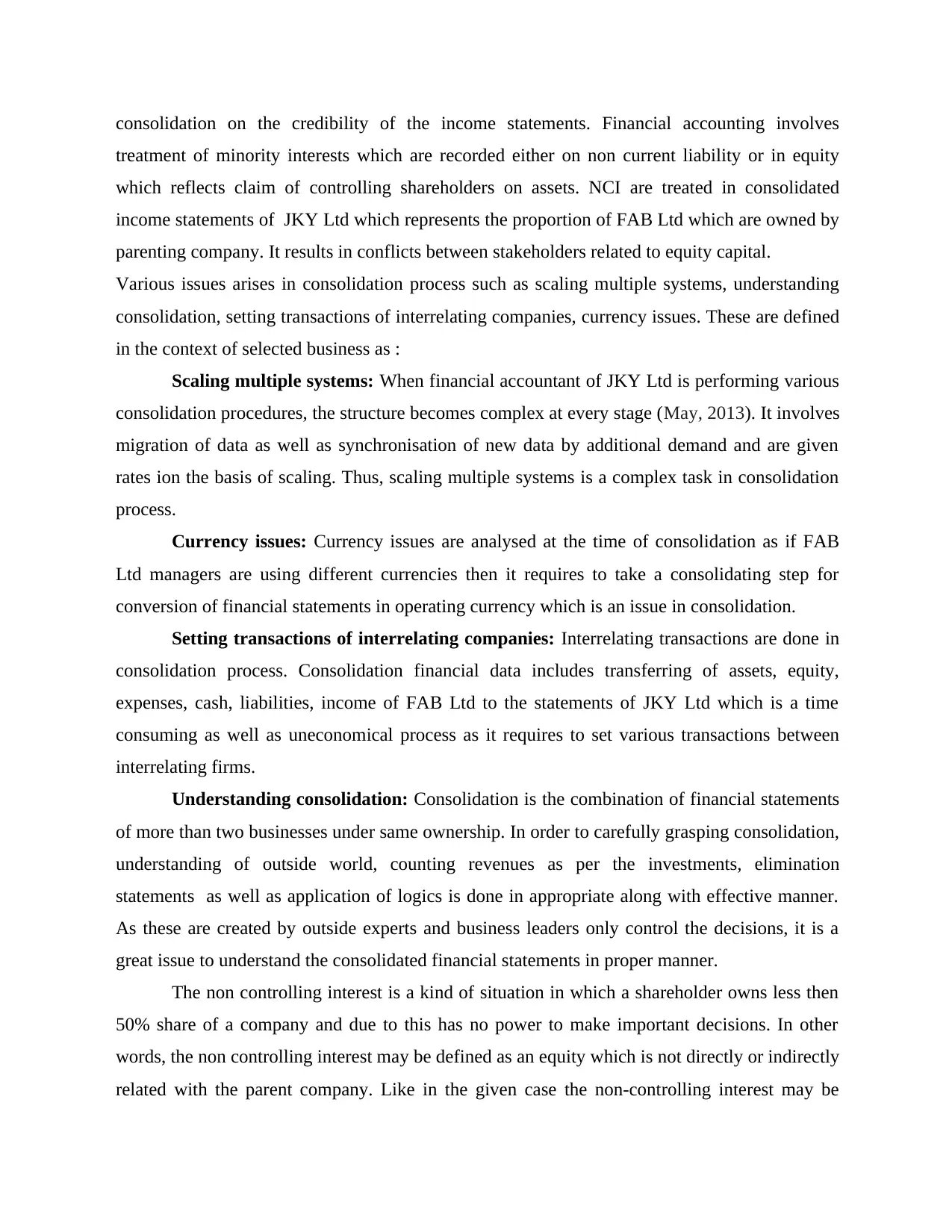
consolidation on the credibility of the income statements. Financial accounting involves
treatment of minority interests which are recorded either on non current liability or in equity
which reflects claim of controlling shareholders on assets. NCI are treated in consolidated
income statements of JKY Ltd which represents the proportion of FAB Ltd which are owned by
parenting company. It results in conflicts between stakeholders related to equity capital.
Various issues arises in consolidation process such as scaling multiple systems, understanding
consolidation, setting transactions of interrelating companies, currency issues. These are defined
in the context of selected business as :
Scaling multiple systems: When financial accountant of JKY Ltd is performing various
consolidation procedures, the structure becomes complex at every stage (May, 2013). It involves
migration of data as well as synchronisation of new data by additional demand and are given
rates ion the basis of scaling. Thus, scaling multiple systems is a complex task in consolidation
process.
Currency issues: Currency issues are analysed at the time of consolidation as if FAB
Ltd managers are using different currencies then it requires to take a consolidating step for
conversion of financial statements in operating currency which is an issue in consolidation.
Setting transactions of interrelating companies: Interrelating transactions are done in
consolidation process. Consolidation financial data includes transferring of assets, equity,
expenses, cash, liabilities, income of FAB Ltd to the statements of JKY Ltd which is a time
consuming as well as uneconomical process as it requires to set various transactions between
interrelating firms.
Understanding consolidation: Consolidation is the combination of financial statements
of more than two businesses under same ownership. In order to carefully grasping consolidation,
understanding of outside world, counting revenues as per the investments, elimination
statements as well as application of logics is done in appropriate along with effective manner.
As these are created by outside experts and business leaders only control the decisions, it is a
great issue to understand the consolidated financial statements in proper manner.
The non controlling interest is a kind of situation in which a shareholder owns less then
50% share of a company and due to this has no power to make important decisions. In other
words, the non controlling interest may be defined as an equity which is not directly or indirectly
related with the parent company. Like in the given case the non-controlling interest may be
treatment of minority interests which are recorded either on non current liability or in equity
which reflects claim of controlling shareholders on assets. NCI are treated in consolidated
income statements of JKY Ltd which represents the proportion of FAB Ltd which are owned by
parenting company. It results in conflicts between stakeholders related to equity capital.
Various issues arises in consolidation process such as scaling multiple systems, understanding
consolidation, setting transactions of interrelating companies, currency issues. These are defined
in the context of selected business as :
Scaling multiple systems: When financial accountant of JKY Ltd is performing various
consolidation procedures, the structure becomes complex at every stage (May, 2013). It involves
migration of data as well as synchronisation of new data by additional demand and are given
rates ion the basis of scaling. Thus, scaling multiple systems is a complex task in consolidation
process.
Currency issues: Currency issues are analysed at the time of consolidation as if FAB
Ltd managers are using different currencies then it requires to take a consolidating step for
conversion of financial statements in operating currency which is an issue in consolidation.
Setting transactions of interrelating companies: Interrelating transactions are done in
consolidation process. Consolidation financial data includes transferring of assets, equity,
expenses, cash, liabilities, income of FAB Ltd to the statements of JKY Ltd which is a time
consuming as well as uneconomical process as it requires to set various transactions between
interrelating firms.
Understanding consolidation: Consolidation is the combination of financial statements
of more than two businesses under same ownership. In order to carefully grasping consolidation,
understanding of outside world, counting revenues as per the investments, elimination
statements as well as application of logics is done in appropriate along with effective manner.
As these are created by outside experts and business leaders only control the decisions, it is a
great issue to understand the consolidated financial statements in proper manner.
The non controlling interest is a kind of situation in which a shareholder owns less then
50% share of a company and due to this has no power to make important decisions. In other
words, the non controlling interest may be defined as an equity which is not directly or indirectly
related with the parent company. Like in the given case the non-controlling interest may be
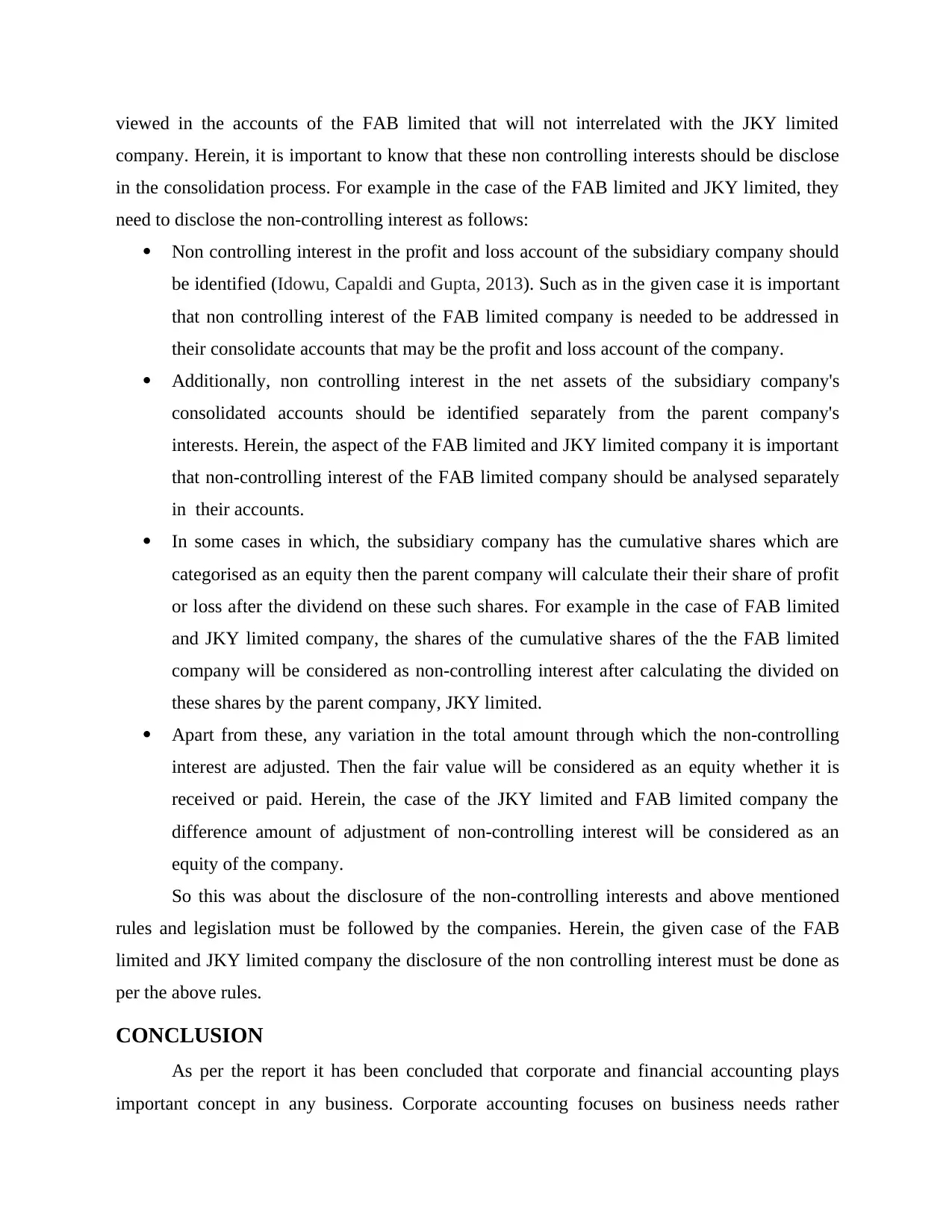
viewed in the accounts of the FAB limited that will not interrelated with the JKY limited
company. Herein, it is important to know that these non controlling interests should be disclose
in the consolidation process. For example in the case of the FAB limited and JKY limited, they
need to disclose the non-controlling interest as follows:
Non controlling interest in the profit and loss account of the subsidiary company should
be identified (Idowu, Capaldi and Gupta, 2013). Such as in the given case it is important
that non controlling interest of the FAB limited company is needed to be addressed in
their consolidate accounts that may be the profit and loss account of the company.
Additionally, non controlling interest in the net assets of the subsidiary company's
consolidated accounts should be identified separately from the parent company's
interests. Herein, the aspect of the FAB limited and JKY limited company it is important
that non-controlling interest of the FAB limited company should be analysed separately
in their accounts.
In some cases in which, the subsidiary company has the cumulative shares which are
categorised as an equity then the parent company will calculate their their share of profit
or loss after the dividend on these such shares. For example in the case of FAB limited
and JKY limited company, the shares of the cumulative shares of the the FAB limited
company will be considered as non-controlling interest after calculating the divided on
these shares by the parent company, JKY limited.
Apart from these, any variation in the total amount through which the non-controlling
interest are adjusted. Then the fair value will be considered as an equity whether it is
received or paid. Herein, the case of the JKY limited and FAB limited company the
difference amount of adjustment of non-controlling interest will be considered as an
equity of the company.
So this was about the disclosure of the non-controlling interests and above mentioned
rules and legislation must be followed by the companies. Herein, the given case of the FAB
limited and JKY limited company the disclosure of the non controlling interest must be done as
per the above rules.
CONCLUSION
As per the report it has been concluded that corporate and financial accounting plays
important concept in any business. Corporate accounting focuses on business needs rather
company. Herein, it is important to know that these non controlling interests should be disclose
in the consolidation process. For example in the case of the FAB limited and JKY limited, they
need to disclose the non-controlling interest as follows:
Non controlling interest in the profit and loss account of the subsidiary company should
be identified (Idowu, Capaldi and Gupta, 2013). Such as in the given case it is important
that non controlling interest of the FAB limited company is needed to be addressed in
their consolidate accounts that may be the profit and loss account of the company.
Additionally, non controlling interest in the net assets of the subsidiary company's
consolidated accounts should be identified separately from the parent company's
interests. Herein, the aspect of the FAB limited and JKY limited company it is important
that non-controlling interest of the FAB limited company should be analysed separately
in their accounts.
In some cases in which, the subsidiary company has the cumulative shares which are
categorised as an equity then the parent company will calculate their their share of profit
or loss after the dividend on these such shares. For example in the case of FAB limited
and JKY limited company, the shares of the cumulative shares of the the FAB limited
company will be considered as non-controlling interest after calculating the divided on
these shares by the parent company, JKY limited.
Apart from these, any variation in the total amount through which the non-controlling
interest are adjusted. Then the fair value will be considered as an equity whether it is
received or paid. Herein, the case of the JKY limited and FAB limited company the
difference amount of adjustment of non-controlling interest will be considered as an
equity of the company.
So this was about the disclosure of the non-controlling interests and above mentioned
rules and legislation must be followed by the companies. Herein, the given case of the FAB
limited and JKY limited company the disclosure of the non controlling interest must be done as
per the above rules.
CONCLUSION
As per the report it has been concluded that corporate and financial accounting plays
important concept in any business. Corporate accounting focuses on business needs rather
⊘ This is a preview!⊘
Do you want full access?
Subscribe today to unlock all pages.

Trusted by 1+ million students worldwide
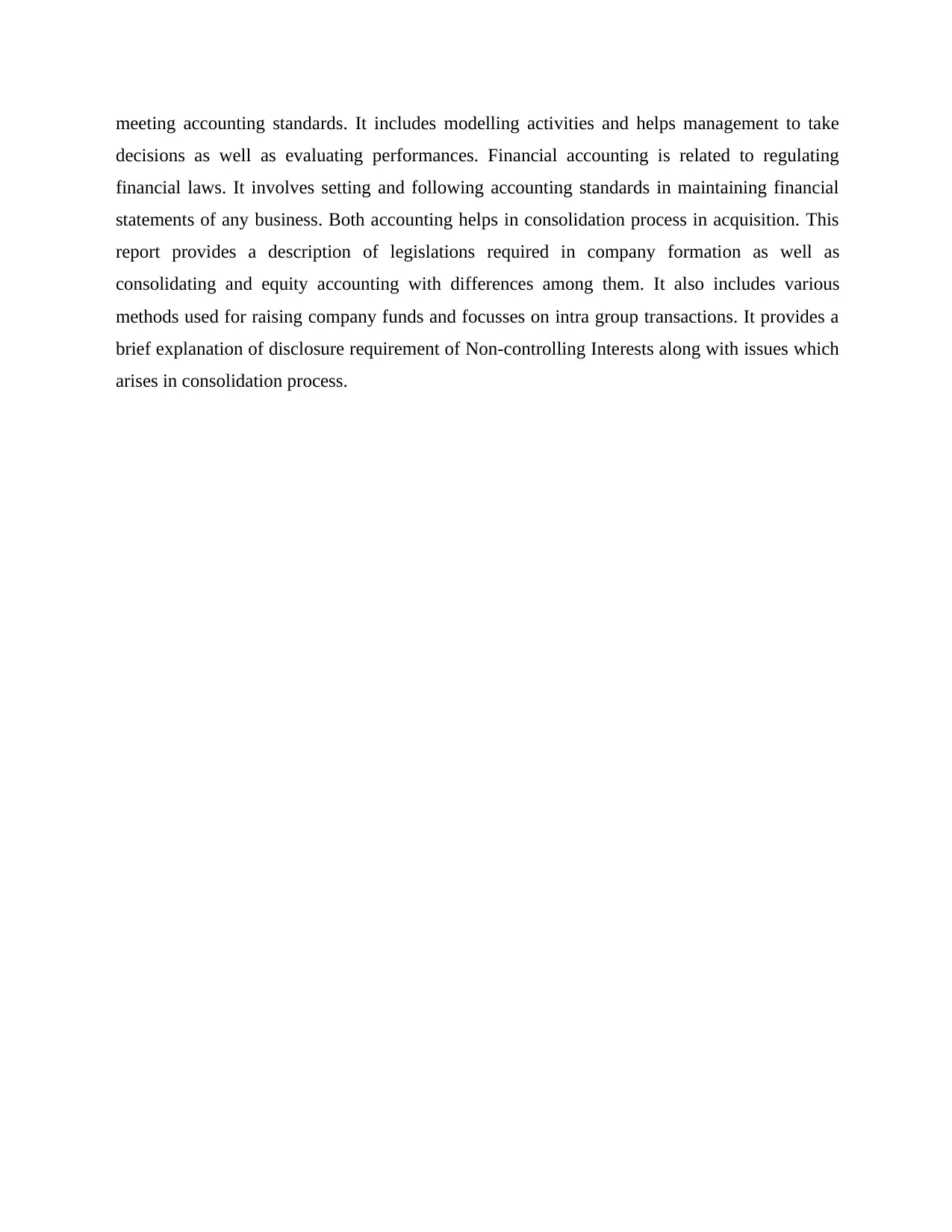
meeting accounting standards. It includes modelling activities and helps management to take
decisions as well as evaluating performances. Financial accounting is related to regulating
financial laws. It involves setting and following accounting standards in maintaining financial
statements of any business. Both accounting helps in consolidation process in acquisition. This
report provides a description of legislations required in company formation as well as
consolidating and equity accounting with differences among them. It also includes various
methods used for raising company funds and focusses on intra group transactions. It provides a
brief explanation of disclosure requirement of Non-controlling Interests along with issues which
arises in consolidation process.
decisions as well as evaluating performances. Financial accounting is related to regulating
financial laws. It involves setting and following accounting standards in maintaining financial
statements of any business. Both accounting helps in consolidation process in acquisition. This
report provides a description of legislations required in company formation as well as
consolidating and equity accounting with differences among them. It also includes various
methods used for raising company funds and focusses on intra group transactions. It provides a
brief explanation of disclosure requirement of Non-controlling Interests along with issues which
arises in consolidation process.
Paraphrase This Document
Need a fresh take? Get an instant paraphrase of this document with our AI Paraphraser
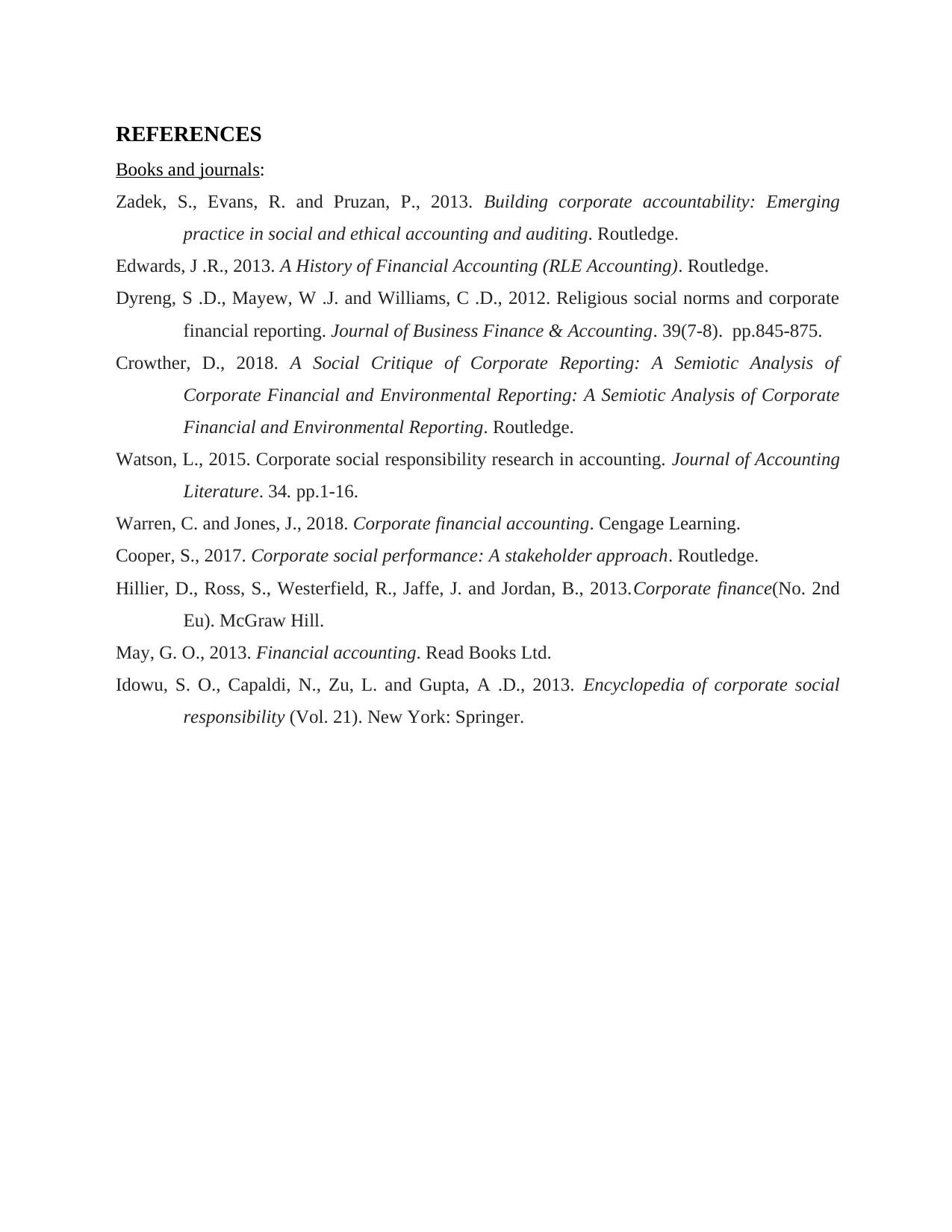
REFERENCES
Books and journals:
Zadek, S., Evans, R. and Pruzan, P., 2013. Building corporate accountability: Emerging
practice in social and ethical accounting and auditing. Routledge.
Edwards, J .R., 2013. A History of Financial Accounting (RLE Accounting). Routledge.
Dyreng, S .D., Mayew, W .J. and Williams, C .D., 2012. Religious social norms and corporate
financial reporting. Journal of Business Finance & Accounting. 39(7‐8). pp.845-875.
Crowther, D., 2018. A Social Critique of Corporate Reporting: A Semiotic Analysis of
Corporate Financial and Environmental Reporting: A Semiotic Analysis of Corporate
Financial and Environmental Reporting. Routledge.
Watson, L., 2015. Corporate social responsibility research in accounting. Journal of Accounting
Literature. 34. pp.1-16.
Warren, C. and Jones, J., 2018. Corporate financial accounting. Cengage Learning.
Cooper, S., 2017. Corporate social performance: A stakeholder approach. Routledge.
Hillier, D., Ross, S., Westerfield, R., Jaffe, J. and Jordan, B., 2013.Corporate finance(No. 2nd
Eu). McGraw Hill.
May, G. O., 2013. Financial accounting. Read Books Ltd.
Idowu, S. O., Capaldi, N., Zu, L. and Gupta, A .D., 2013. Encyclopedia of corporate social
responsibility (Vol. 21). New York: Springer.
Books and journals:
Zadek, S., Evans, R. and Pruzan, P., 2013. Building corporate accountability: Emerging
practice in social and ethical accounting and auditing. Routledge.
Edwards, J .R., 2013. A History of Financial Accounting (RLE Accounting). Routledge.
Dyreng, S .D., Mayew, W .J. and Williams, C .D., 2012. Religious social norms and corporate
financial reporting. Journal of Business Finance & Accounting. 39(7‐8). pp.845-875.
Crowther, D., 2018. A Social Critique of Corporate Reporting: A Semiotic Analysis of
Corporate Financial and Environmental Reporting: A Semiotic Analysis of Corporate
Financial and Environmental Reporting. Routledge.
Watson, L., 2015. Corporate social responsibility research in accounting. Journal of Accounting
Literature. 34. pp.1-16.
Warren, C. and Jones, J., 2018. Corporate financial accounting. Cengage Learning.
Cooper, S., 2017. Corporate social performance: A stakeholder approach. Routledge.
Hillier, D., Ross, S., Westerfield, R., Jaffe, J. and Jordan, B., 2013.Corporate finance(No. 2nd
Eu). McGraw Hill.
May, G. O., 2013. Financial accounting. Read Books Ltd.
Idowu, S. O., Capaldi, N., Zu, L. and Gupta, A .D., 2013. Encyclopedia of corporate social
responsibility (Vol. 21). New York: Springer.
1 out of 11
Related Documents
Your All-in-One AI-Powered Toolkit for Academic Success.
+13062052269
info@desklib.com
Available 24*7 on WhatsApp / Email
![[object Object]](/_next/static/media/star-bottom.7253800d.svg)
Unlock your academic potential
Copyright © 2020–2025 A2Z Services. All Rights Reserved. Developed and managed by ZUCOL.




